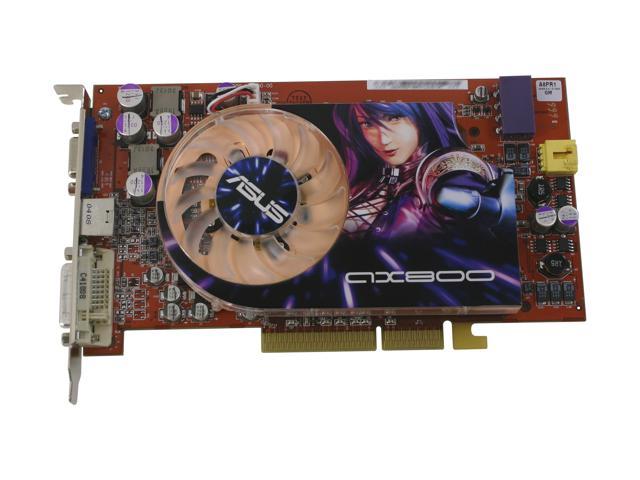ASUS AX800 XT / TVD video adapter review – Currently, the following situation has developed on the video adapter market: high-end models from both ATI Technologies and NVIDIA Corporation, belonging to the new generation, are practically not found on the free market. We are talking about video adapters RADEON X800 XT Platinum Edition and GeForce 6800 Ultra, respectively.
The situation with the GeForce 6800 Ultra is already well known to everyone, but the lack of a sufficient number of RADEON X800 XTs on the market looks rather strange in light of the fact that ATI’s technical process is properly debugged and the yield of suitable crystals is very high.
What is the reason, we can only speculate, but the fact remains – RADEON X800 XT is present on the market in extremely small quantities; it is not surprising that the prices for this product are quite high and are in the region of $ 600- $ 700. I can only hope that the situation will change for the better in the near future, and RADEON X800 XT video adapters, which can offer the highest level of performance, will finally appear on store shelves in sufficient quantities. In the meantime, enthusiasts who do not pay attention to high prices are on the hunt for these cards.
It should be said that, in our opinion, the reference cooling system RADEON X800, as well as its slightly enlarged version from ASUS, can hardly be called successful solutions – if these systems usually cope with cooling the RADEON X800 PRO without much difficulty, then the hotter RADEON The X800 XT can hardly be tough for them, and in the case of a cramped case, a case not equipped with additional fans, as well as in hot weather, these cards often overheat and freeze. In any case, we have come across this several times while working on reviews devoted to graphic adapters belonging to the RADEON X800 family.
Some manufacturers, such as Sapphire and HIS, recognize the importance of this problem and complete some cards of this family with powerful and efficient cooling systems. Why doesn’t ASUS, which once created an excellent cooling system for its RADEON 9800 XT, we can only guess. Installation of such a cooling system, of course, would slightly increase the cost of X800-based cards, but these products are already positioned by the company as top-class solutions for enthusiastic gamers who, as a rule, do not pay much attention to the price of their favorite video adapter.
Not so long ago, we published a review of the ASUS AX800 PRO / TD video adapter , which deservedly received high marks, especially for the richest package bundle and excellent 2D quality. However, this product, like almost any product, was not devoid of certain drawbacks – in its case, such a drawback was a relatively ineffective cooling system with an incompletely realized potential, as well as the absence of heatsinks on memory chips.
Of course, such a large and well-known company as ASUSTeK did not limit itself to the release of a junior model in the X800 family, but expanded the lineup with an older sixteen-pipe model called ASUS AX800 XT / TVD.
This is what we will examine in our today’s review, along the way finding out whether the manufacturer has corrected the shortcomings of the cooling system. Like ASUS AX800 PRO, the AX800 XT video adapter came to us in a version intended for retail sale – in a colorful box of incredible dimensions, which has already become a kind of symbol of high-end video cards from this manufacturer.
This time, the company decided not to change the design of the box and made it the same for the entire AX800 family. As in the case of ASUS AX800 PRO, the box pleased us with rich content:

Video adapter ASUS AX800 XT / TVD (a transparent plastic box)
Quick Start Guide video
Detailed Installation Guide video
List Performance video
Guide to the bundled software
adapter DVI-I -> D-Sub
Adapter S-Video -> RCA
splitter S- Video -> YPbPr (HDTV)
VIVO
Splitter Molex Power Splitter
ASUS Webcam Box
Instead of S-Video and RCA cables, there was a special splitter in the kit, which can be connected to the universal VIVO connector. It is not as convenient as the switching unit that was supplied with the ASUS RADEON 9800 XT / TVD, but it does its job.
The contents of the orange plastic software box are unchanged from the AX800 PRO; the following disks were found in it:
CD with ASUS drivers and utilities CD with ASUS
DVD player
CD with ASUS PowerDirector 3DE software
CD with CyberLink MediaShow SE 2.0
CD with Ulead Cool 3D SE 3.0 and Photo Express SE 4.0 software
2 CD with Deus Ex: Invisible War
2 CD with game CounterStrike: Condition Zero
In this case, the presence in the set of software designed for working with video is quite justified, since ASUS AX800 XT / TVD is equipped with a RageTheater chip that allows it to capture video signals. Like the AX800 PRO model, this card supports proprietary technologies ASUS GameFace, ASUS Video Security and ASUS Smart Doctor, which have been repeatedly described in our reviews of video adapters from this manufacturer. You can familiarize yourself with these technologies by reading our review of ASUS V9950 or ASUS RADEON 9800 XT / TVD . Their brief description is also contained in the review of ASUS AX800 PRO / TD , where the webcam included in the package is also described in detail.
Taking the card in his hands
ASUS AX800 XT / TVD differs insignificantly from its younger brother, which, however, is not surprising – all cards belonging to the X800 family use the same reference PCB design.
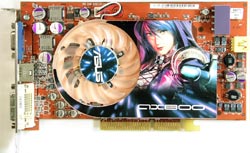

In this case, all the external differences, in fact, lie in the presence on board the AX800 XT of the RageTheater chip, the accompanying small logic, as well as the yellow connector located next to the connector for connecting the additional power supply. This connector, which looks like an audio input, is actually used to connect an additional video input connector, which can be located, for example, on the front of the PC case.
In addition to the external differences described above, there are internal ones, which are much more important. One of them is that the ASUS AX800 XT is equipped with faster GDDR3 memory from Samsung with an access time of 1.6 nanoseconds, versus 2 nanoseconds for the memory installed on the AX800 PRO. As befits any RADEON X800 XT, the memory operates at 560 (1120) MHz, and the VPU core – at 520 MHz. All 16 pixel pipelines are activated in this case, unlike the AX800 PRO (and any other RADEON X800 PRO), where only 12 pipelines work.
As for the cooling system, it is completely similar to the one that the company equipped the AX800 PRO with. Accordingly, it inherited its main drawback – the lack of cooling for memory chips, although its implementation would not cause any difficulties for ASUS. Since the memory in this case operates at a higher frequency than in the AX800 PRO, the need for cooling is even higher, but, alas, this possibility has remained unrealized. Looking ahead, the card overheated during testing, as the weather was hot enough these days. Overheating led to frequent system freezes, which we managed to get rid of by installing an additional 120 mm fan that blows the card from the end side. Thus, the air flow was dissected by the board and hit both the front and back sides of the PCB, cooling the memory chips. Probably, the problem could have been avoided if ASUS had installed thermal spacers on the memory chips located under the cooler base and passive heatsinks on the microcircuits installed on the reverse side of the PCB.
Considering the higher level of heat dissipation than that of the AX800 PRO, we believe that this video adapter will not experience any problems, only being installed in a case with additional airflow and a well-thought-out air flow configuration; otherwise, the possibility of overheating and freezing is not excluded, especially in the summer.
Acceleration, noise and 2D quality
All the praises that were expressed to the ASUS AX800 PRO regarding its quietness and excellent 2D quality can well be applied to the product we are describing today. The cooler makes noise only in the first couple of seconds after turning on the PC, after which it switches to reduced speed and becomes almost completely silent. When the VPU core reaches a certain temperature, the cooler is able to increase the speed, but this happens very rarely. 2D quality was also in no way inferior to the younger model – the AX800 XT showed crystal clear images in all resolutions supported by our laboratory monitor, including 1800x1400x75 Hz.
Overclocking, on the contrary, turned out to be quite average – with additional airflow, the core was overclocked to 555 MHz, after which the card began to work unstable. The memory was overclocked even less – only up to 570 (1140) MHz; with a further increase in frequency by at least 5 MHz, the card began to “delight” us with image artifacts and frequent system freezes, so we had to stop at the above figures. Perhaps we could have achieved more with a water or cryogenic cooling system, but such overclocking is more related to extreme sports than to inexpensive and affordable methods of increasing performance.
In-game testing: test platform configuration and list of applications
For testing, we used our standard lab platform with the following configuration:
Athlon 64 3400+ CPU (Socket 754, 2.20GHz, 1MB L1 cache);
ASUS K8V Deluxe mainboard;
OCZ PC-3200 Platinum EB DDR SDRAM (2x512MB, CL2.5-3-2-8);
Seagate 7200.7 HDD (SerialATA-150, 8MB buffer);
Creative SoundBlaster Audigy 2;
Microsoft Windows XP Pro SP2, DirectX 9.0с;
ATI CATALYST 4.8, NVIDIA ForceWare 61.77.
This time, the list of tests includes the following games and applications:
3D first-person shooters:
Call of Duty;
Doom III;
Unreal Tournament 2004;
Halo: Combat Evolved;
FarCry;
Painkiller;
Counter Strike: Source;
Highly Anticipated DX9 Game 1;
Highly Anticipated DX9 Game 2.
3D shooters with a third person view:
Splinter Cell: Pandora Tomorrow;
Prince of Persia: Sands of Time;
Max Payne 2: The Fall of Max Payne.
Simulators:
IL-2 Sturmovik: Aces in the Sky;
Lock On;
Colin McRae Rally 04.
Strategies:
Command & Conquer Generals: Zero Hour;
Perimeter.
Semi-synthetic tests:
Aquamark3.
Synthetic tests:
Futuremark 3DMark03 build 340.
In each specific case, the graphics quality settings were set to the highest possible level, the same for cards from ATI and NVIDIA.
Game tests: Call of Duty
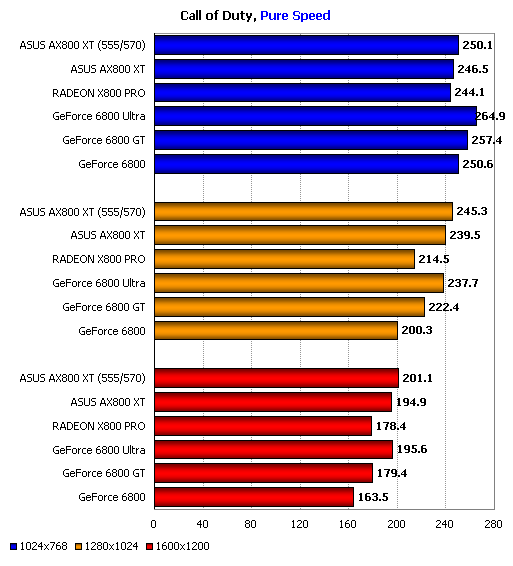
Call of Duty is an uncomplicated game for today, so modern high-end video adapters demonstrate three-digit FPS values in it. In this case, ASUS AX800 XT shows practically the same performance as the GeForce 6800 Ultra, except for the resolution of 1024×768. Overclocking has a very weak effect.
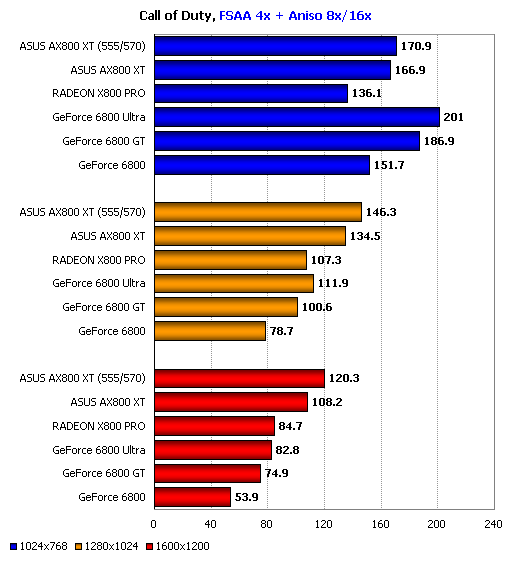
In FSAA + AF mode at 1024×768 the same strange picture is observed as in the previous case, however, already at 1280×1024 everything falls into place – efficient methods of working with memory make ASUS AX800 XT a leader. The effect of overclocking is greater here, since in this mode the memory load is higher.
Game tests: Doom III
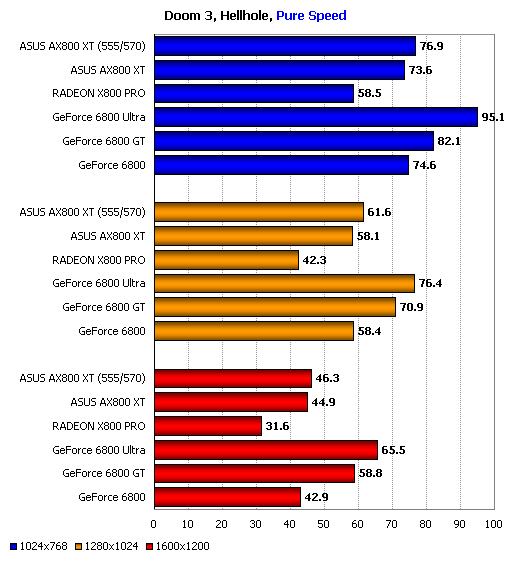
Doom 3 prefers cards based on NVIDIA architectural solutions, so ASUS AX800 XT in this case cannot compete in performance with representatives of the GeForce 6800 family.
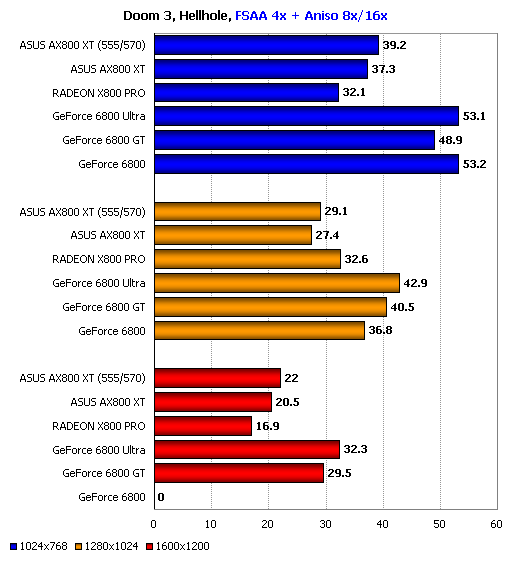
The same is observed when you enable full-screen anti-aliasing, coupled with anisotropic filtering. Still, the new id Software engine gravitates too much towards NVIDIA solutions; in addition, the OpenGL driver used by ATI Technologies is hopelessly outdated. Perhaps, in the new versions of CATALYST we will see a significant increase in performance in Doom 3, but the situation in this game is not so good for cards from ATI Technologies. Due to the memory size of 128 MB, the GeForce 6800 was unable to use full-screen anti-aliasing and anisotropic filtering at 1600×1200.
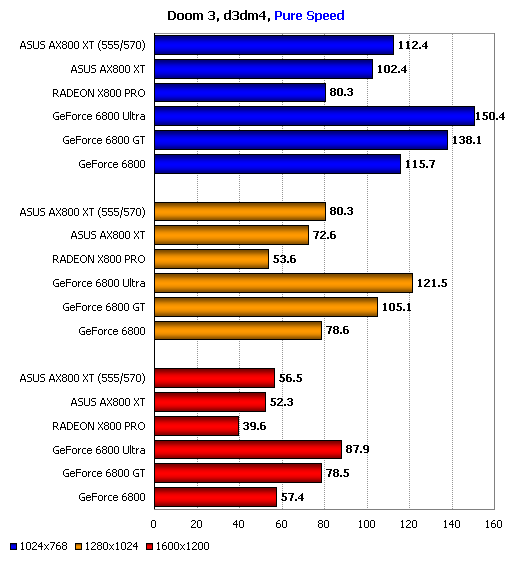
Everything that was said above in relation to the Hellhole level is also true for the d3dm4 level – cards based on the R420 GPU from ATI hopelessly lag behind cards using NVIDIA NV40. Once again, the problem in this case is not only the mutual fitness of Doom 3 and NVIDIA GPUs, but also the outdated and ineffective OpenGL driver included in ATI CATALYST.
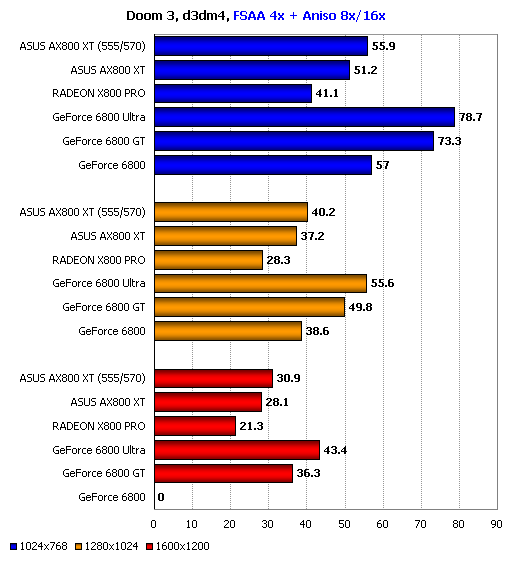
When FSAA and anisotropic filtering are enabled, nothing stands out – the GeForce 6800 cards are still the leaders.
Game tests: Unreal Tournament 2004
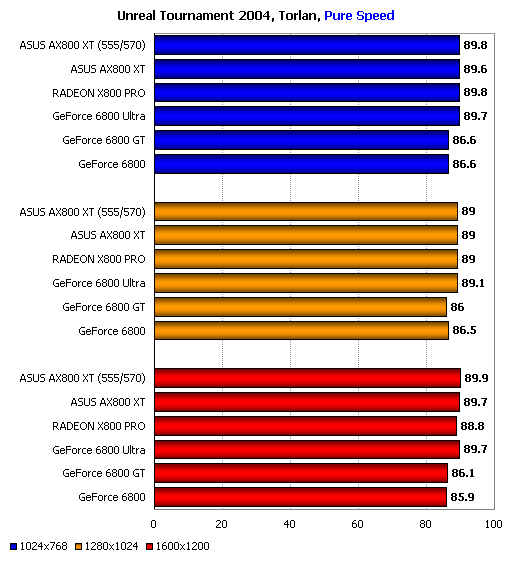
Unreal Tournament 2004 is no longer something super difficult for cards in the upper price range either. As you can see, the specifics of the Torlan level are such that all cards at all resolutions demonstrate approximately the same performance, since the limit here is the speed of the system’s central processor, and it is this limit that all test participants rest against.
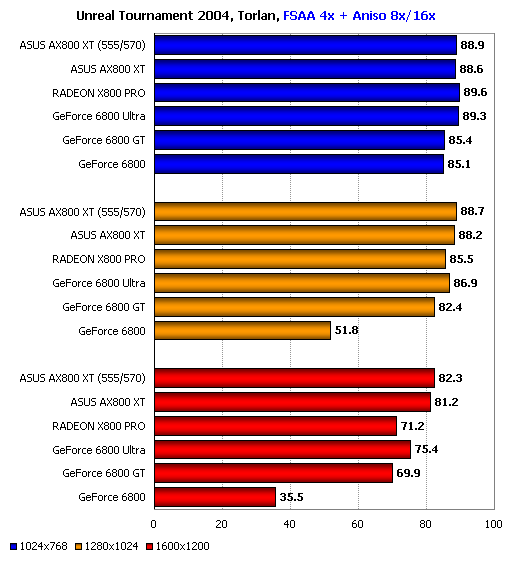
The performance difference is practically invisible even in EyeCandy mode, except for the 1600×1200 resolution, in which the ASUS product demonstrates the best results both in the nominal mode and during overclocking. However, with figures of the order of 80 frames per second, the superiority of 5-6 FPS can hardly be called significant. GeForce 6800 shows an unusually low result, which, however, is quite understandable – the card is hindered by the presence of slow memory.
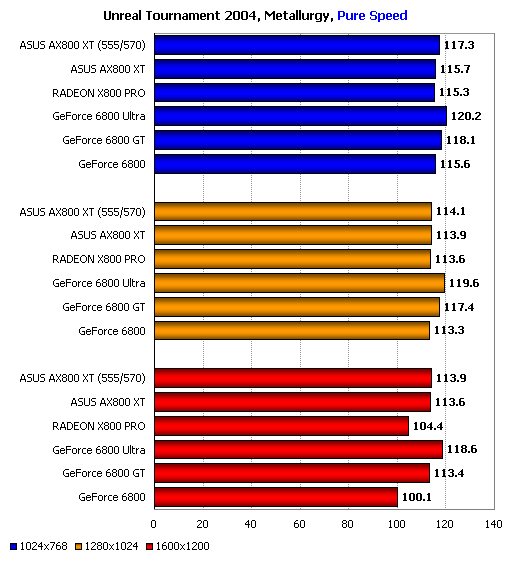
Metallurgy’s level is not as complex as Torlan’s and depends less on CPU performance, so the difference in performance between the tested cards can be seen much better. Since the load at this level is mainly geometrical, it is not surprising that the GeForce 6800 Ultra performs slightly better than the ASUS product.
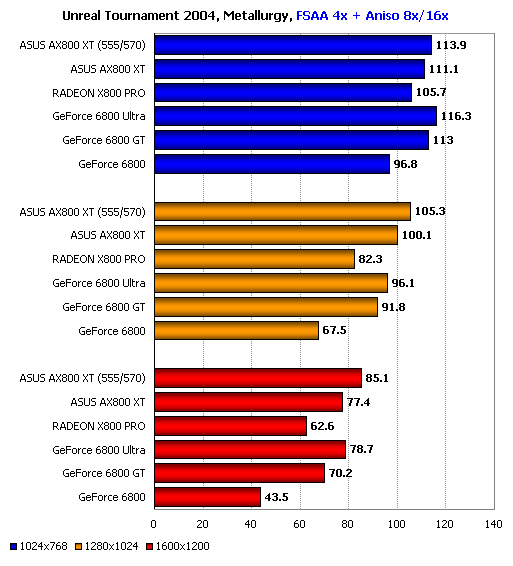
In Eye Candy mode, the situation looks like this – AX800 XT is on a par with GeForce 6800 Ultra; sometimes, there is an almost imperceptible advantage in one direction or another. Overclocking makes the ASUS card the leader, although its advantage is not great.
Game Tests: Halo: Combat Evolved
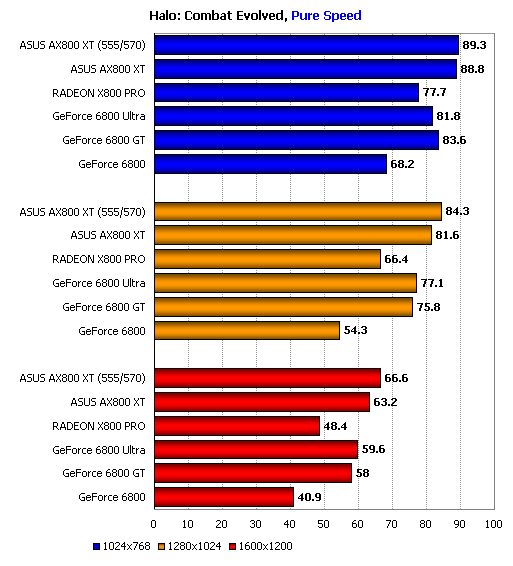
Halo is not a new game anymore; moreover, it is, in fact, a port from the Microsoft Xbox console, due to which the textures used in it do not differ in complexity. However, there are a lot of pixel shaders in the game, so the ASUS AX800 XT has some advantage, since the members of the RADEON X800 family historically cope with pixel shaders better than cards belonging to the GeForce 6800 family. The effect of overclocking is not great in this case either.
Game tests: Far Cry
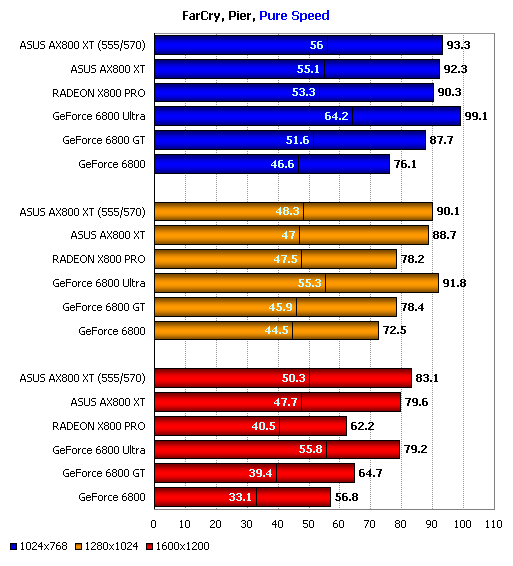
In this game in low resolution the GeForce 6800 Ultra demonstrates the best result, however, already at 1280×1024 it catches up with ASUS AX800 XT. Overclocking the latter gives practically no performance gain in this game.
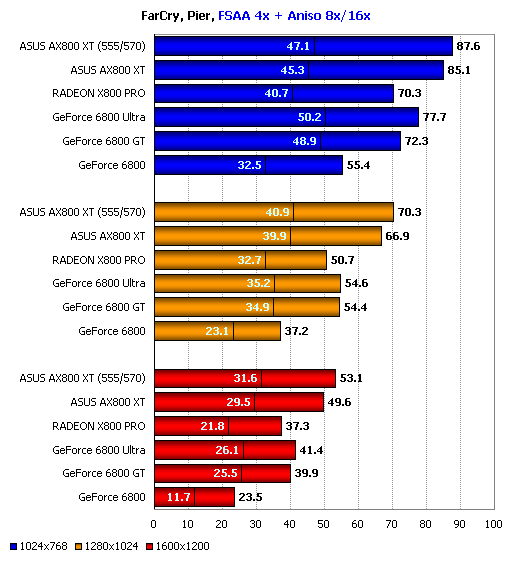
With the simultaneous inclusion of full-screen anti-aliasing and anisotropic filtering, the ASUS product leaps ahead – its adaptability to such operating modes affects. The effect of overclocking is again insignificant, almost imperceptible against the background of total FPS values reaching 87 frames per second.
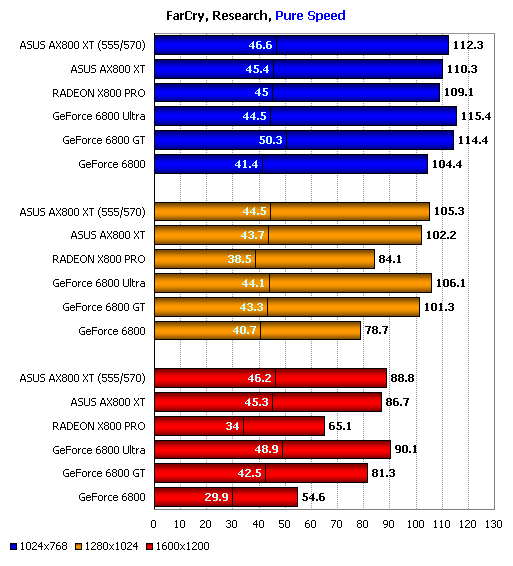
At the Research level, the main rivals ASUS AX800 XT and GeForce 6800 Ultra also demonstrate practically the same results, despite the fact that the nature of the scene here is completely different than in the demo recorded at the Pier level.
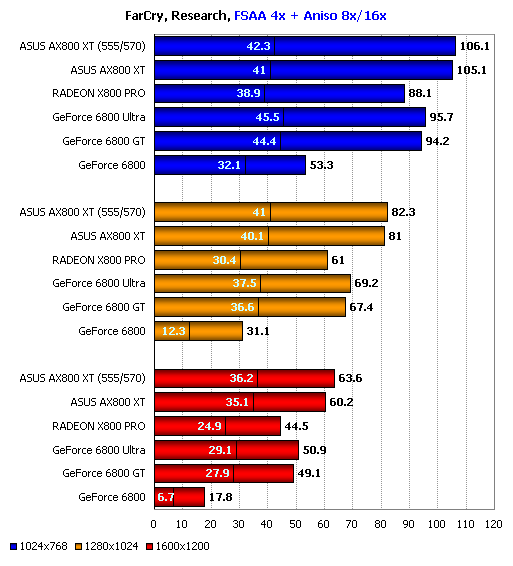
There is nothing new or unusual in Eye Candy mode either – the more efficient R420 architecture in such cases helps ASUS AX800 XT to outperform the GeForce 6800 Ultra. Moreover, even the 12-pipe RADEON X800 PRO demonstrates results comparable to those of high-end cards from NVIDIA. As for the 12-pipe solution from NVIDIA, it is again sorely lacking in fast memory.
Game Tests: Painkiller
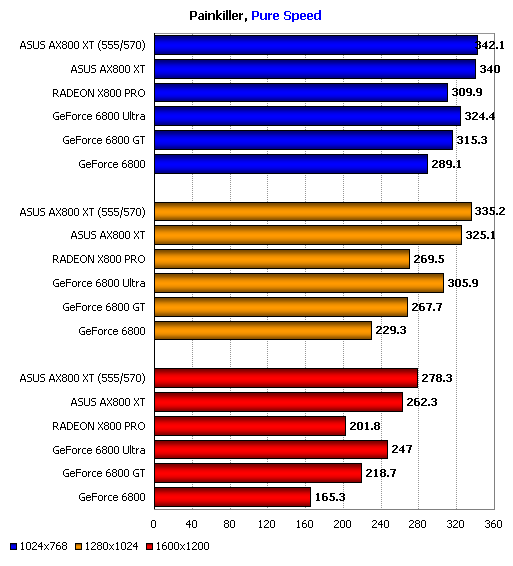
This game, as you know, is famous for its undemandingness, and cards belonging to the highest price range often show values in excess of 200-300 frames per second. In this case, just such a picture is observed. ASUS AX800 XT, which works better with pixel shaders and has a higher frequency, outperforms the GeForce 6800 Ultra by about 20 FPS, which, however, is not so much with the overall values of about 250-300 FPS.
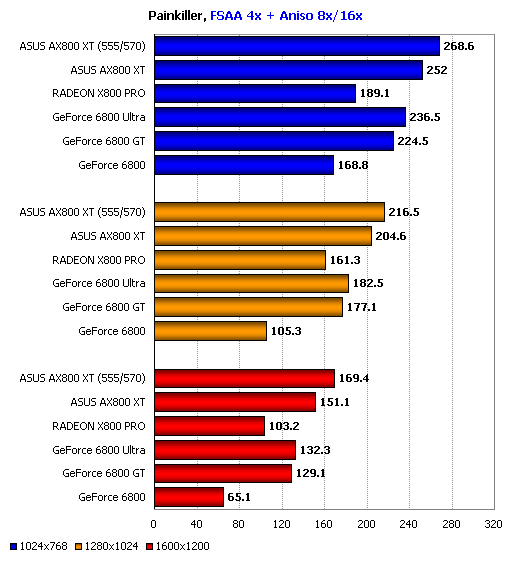
When tested with full-screen anti-aliasing and anisotropic filtering enabled, ASUS AX800 XT outperforms GeForce 6800 Ultra even more significantly. The performance gain from overclocking the described product in Eye Candy mode is also slightly higher than in Pure Speed mode.
Game tests: Counter-Strike: Source
For the first time, when writing a review of a serial video adapter, we used the full version of Counter-Strike: Source , which was released not so long ago. This online first-person shooter is built on the basis of the Half-Life 2 engine, so it is replete with beautiful high-resolution textures, as well as a considerable number of pixel shaders. CS: Source rightfully belongs to the next generation of games. For this game, the test platform configuration was the same as for other games, except for the central processor – in this case, we used AMD Athlon 64 3200+. We remind you that now all tests of AGP cards will be carried out on a platform equipped with this particular processor.
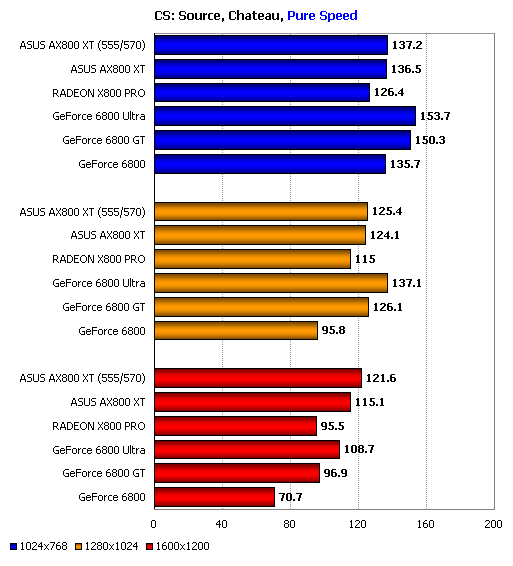
In the final version of Counter-Strike: Source, at the Chateau level, in the first two resolutions the leader is GeForce 6800 Ultra, however, at 1600×1200 it catches up with ASUS AX800 XT. Apparently, the level is not complex enough and saturated with pixel shaders, although the water surface is abundant on it. As far as overclocking is concerned, it is ineffective, although it gives a small performance boost.

In Eye Candy mode, the ASUS brainchild is inferior to the GeForce 6800 Ultra only in the lowest resolution, but already at 1280×1024 it goes on a par with it and then widens the gap in the 1600×1200 resolution. Overclocking the AX800 XT pays much more in this mode than in Pure Speed mode – an increase of about 10 percent at the highest resolution.
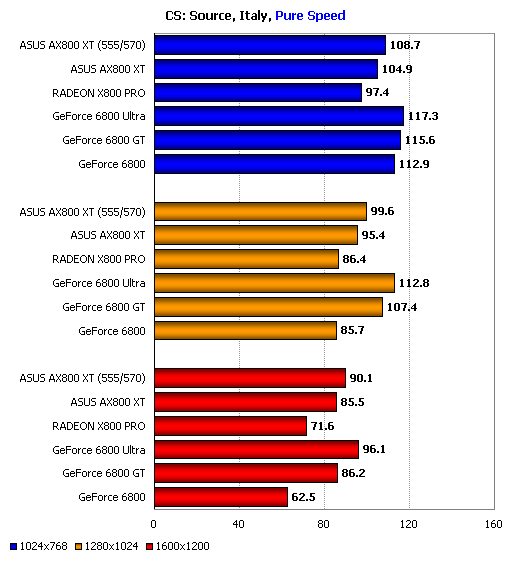
At the Italian level, the picture is somewhat different – in all three resolutions the GeForce 6800 Ultra remains the leader, although the overclocking of ASUS AX800 XT makes it possible to slightly narrow the gap between the two main rivals.
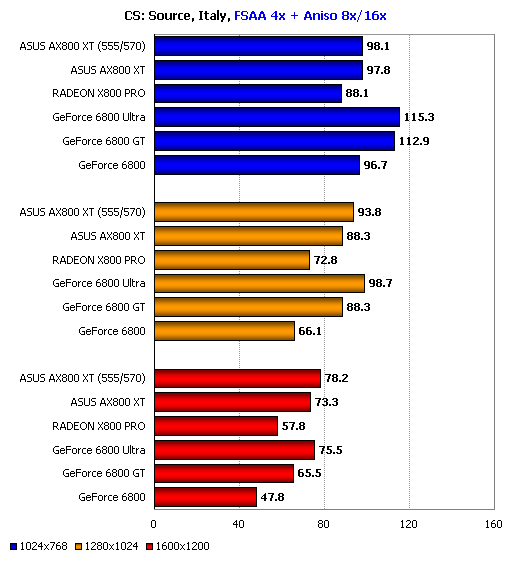
With FSAA and anisotropic filtering enabled, the situation resembles that observed at the level of Chateau – ASUS AX800 XT starts and loses, however, as the resolution grows, it gradually reaches the level of GeForce 6800 Ultra, which is somewhat helped by overclocking, which, however, does not have a very large effect.
Game tests: Highly Anticipated DX9 Game 1
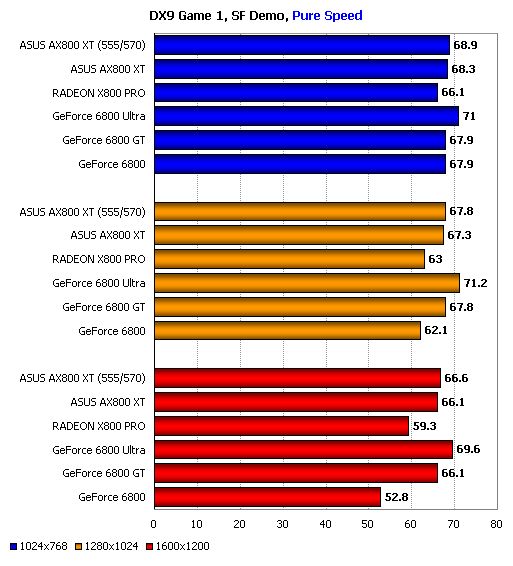
In the first next-gen game we use, all 16-pipelined cards demonstrate the same performance in Pure Speed mode, hitting the ceiling set by the CPU of our test system.
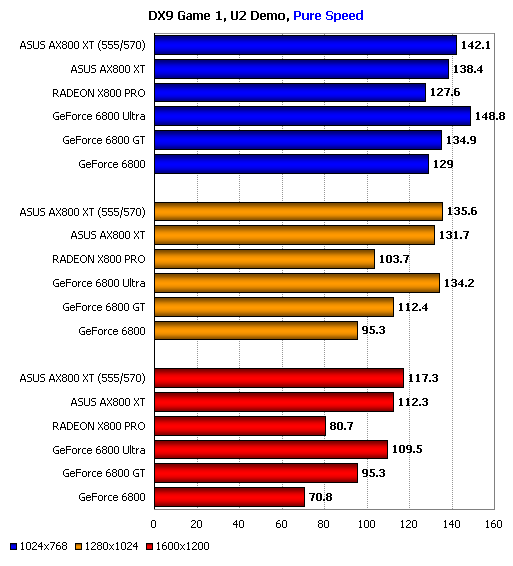
The Under Two level is not so much dependent on the speed of the CPU, so it better allows you to evaluate the performance of fast video adapters. And again we see parity between ASUS AX800 XT and GeForce 6800 Ultra. An exception is the resolution of 1024×768, but it seems that CPU speed plays a greater role than video adapter performance.
Game tests: Highly Anticipated DX9 Game 2
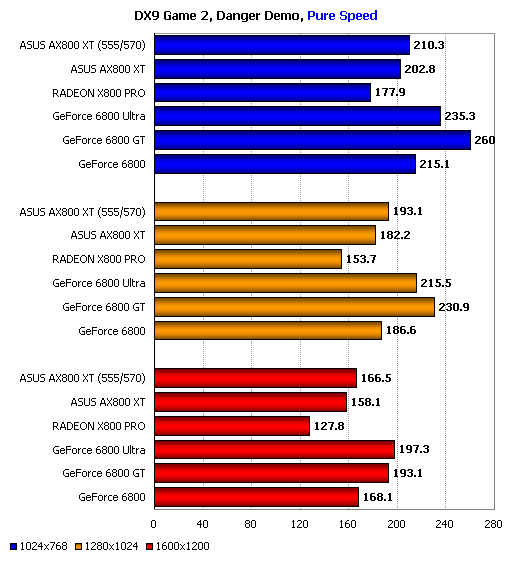
The second next generation game uses only DirectX 7 capabilities; there are no pixel shaders in the preliminary version, which we used for testing, – only the fixed TnL capabilities are used. NVIDIA GPUs contain some optimizations designed to work with such applications, so the results shown in the diagram are quite natural.
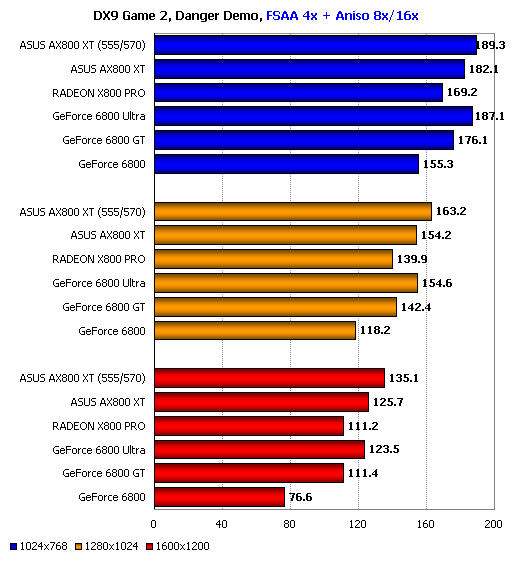
Nevertheless, in Eye Candy mode, the ASUS card manages to catch up with its main rival, the GeForce 6800 Ultra, thanks to excellent memory bandwidth saving algorithms.
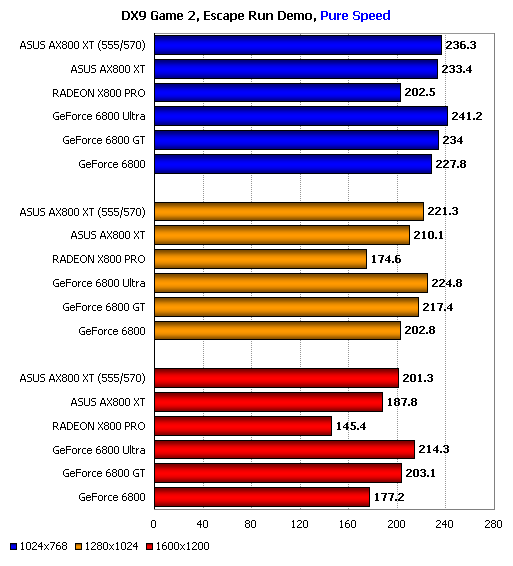
At the Escape Run level, NVIDIA wins again, however, here its victory does not look as uncompromising as in the previous case – the gap from ASUS AX800 XT is small and ranges from 8 to 27 frames per second, which is quite a bit against the background of general indicators in the region 200 FPS.
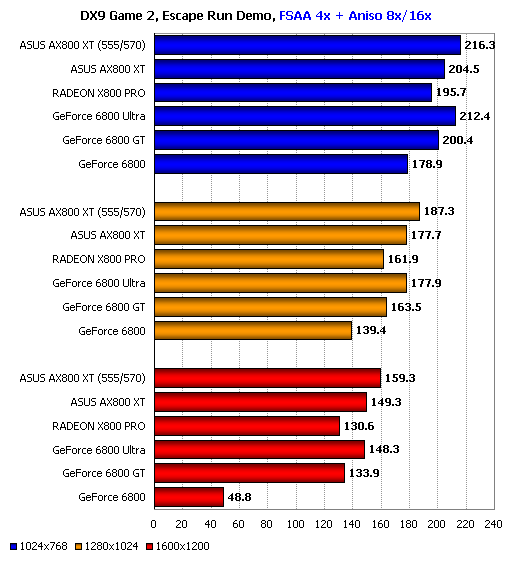
With FSAA and AF enabled at this level, the ASUS product also demonstrates the same performance level as the GeForce 6800 Ultra, and even slightly outperforms it when overclocked.
Game tests: Splinter Cell: Pandora Tomorrow
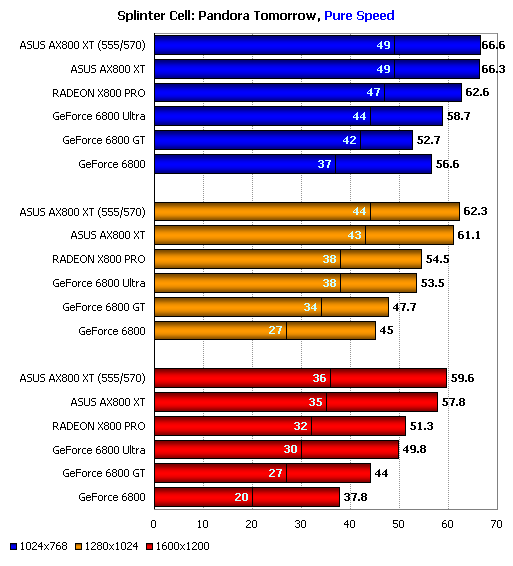
In this game, victory is rightfully awarded to the ASUS AX800 XT. The origins of this victory lie in the ability of ATI’s next-generation GPUs to quickly process the complex pixel shaders of this game. They are used to create beautiful special effects. As for the textures, they are not very difficult here, since this game is also a port from the game console. This game is tested in manual mode, so the test results may not be entirely accurate, since it is difficult to accurately repeat the path of the main character.
Game tests: Prince of Persia: Sands of Time
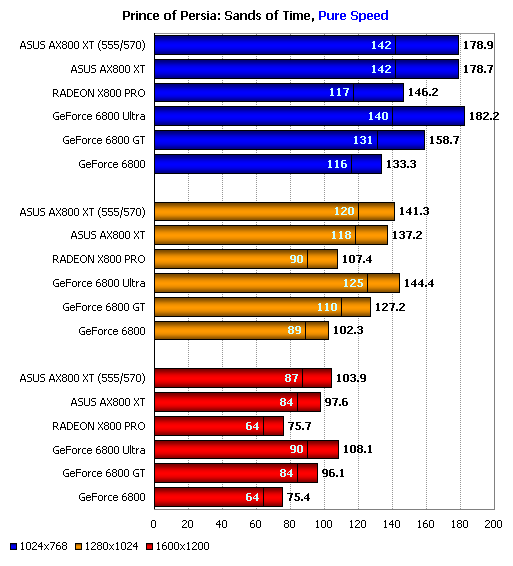
Another well-known game with a third-person view – and again parity, however, with a slight advantage towards NVIDIA. However, this margin does not exceed 10 FPS at the highest resolution, with an overall performance of about 100 frames per second. Overclocking ASUS AX800 XT slightly increases performance, but only slightly – no more than 4-6 FPS. We remind you that this game is not very rich in complex pixel shaders.
Game tests: Max Payne 2: The Fall of Max Payne
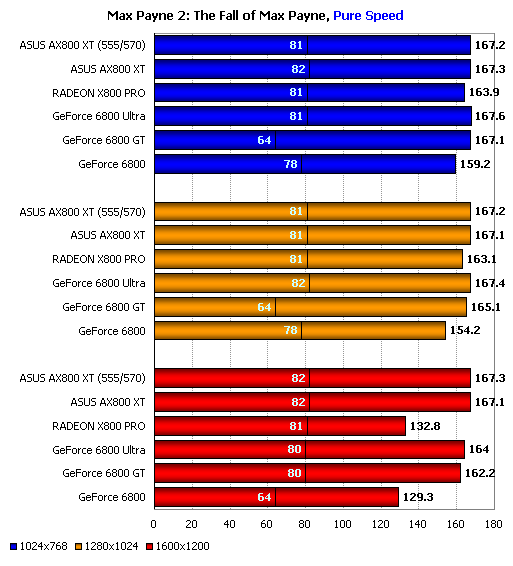
In Max Payne 2 in Pure Speed mode, all high-end 16-pipe cards perform equally well. The reason is the same – the performance ceiling set by the central processor of the system has been reached.
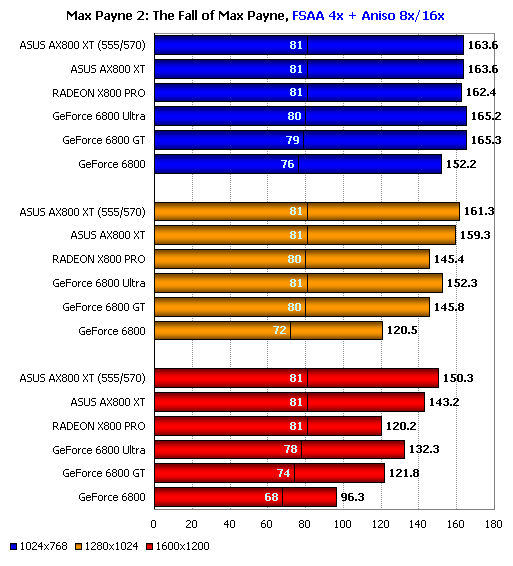
The real difference in performance between modern high-end video adapters in Max Payne 2 is visible only in EyeCandy mode, starting with a resolution of 1280×1024 and higher – in this case, ASUS AX800 XT slightly outperforms the GeForce 6800 Ultra.
Game tests: IL-2 Sturmovik: Aces in the Sky
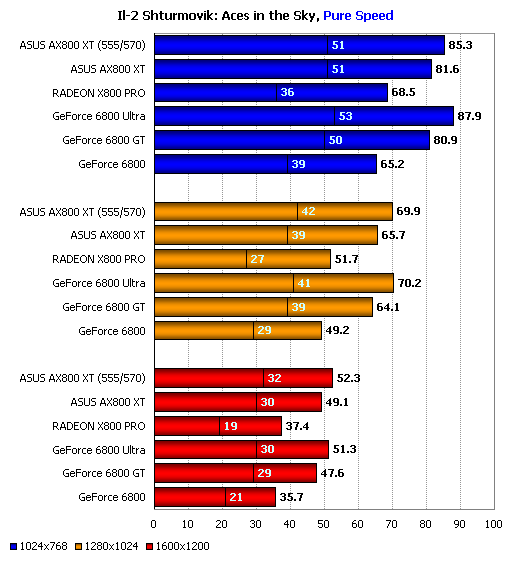
The latest version of the popular IL-2 Sturmovik flight simulator, Aces in the Sky, is a game that is extremely demanding on the video adapter and loves both high processing speed of pixel shaders and high scene filling speed. The GeForce 6800 Ultra performs better with the fill rate, while the ASUS AX800 XT works faster with pixel shaders. On the whole, the GeForce 6800 is slightly ahead of the card from ASUS, but again, the gap between them is small and is easily compensated by the overclocking of the AX800 XT.
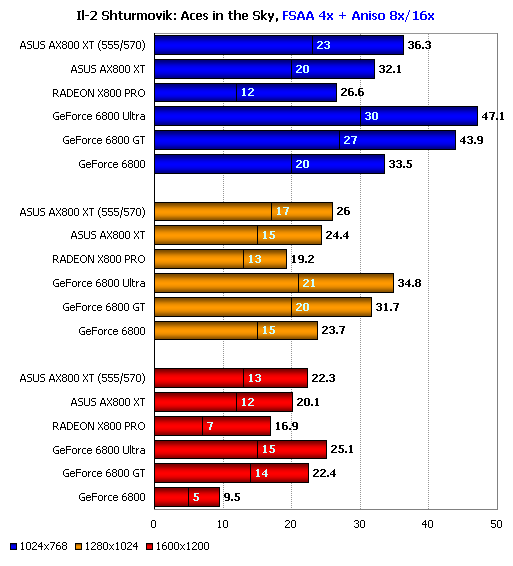
A picture uncharacteristic for cards based on ATI graphics processors – when FSAA and anisotropic filtering are enabled, they often turn out to be ahead, thanks to a more advanced mechanism for working with video memory, however, in this case, the opposite picture is observed – representatives of the GeForce 6800 family, with the exception of 12 conveyor model, far outperform the ASUS AX800 XT. What caused this, we cannot say with certainty; perhaps the ATI OpenGL driver is to blame.
Game Tests: Lock On
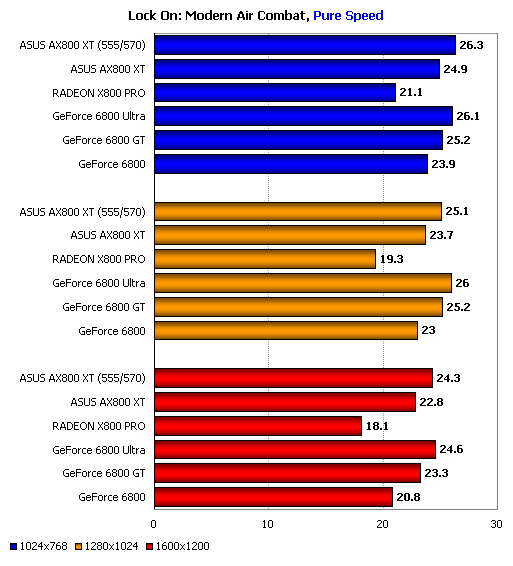
Lock On does not use complex pixel shaders, however, despite this, it is distinguished by hardware requirements, since it demonstrates rather complex effects, in particular, multilayer clouds. In addition, the game is inconsistent in terms of preserving graphics quality settings and sometimes does not allow setting the same quality for different platforms and / or cards, so the results obtained in it should be taken with caution. In this case, the first place is shared by the GeForce 6800 Ultra and the overclocked ASUS AX800 XT. The second place goes to ASUS AX800 XT operating at nominal frequencies, as well as GeForce 6800 GT.
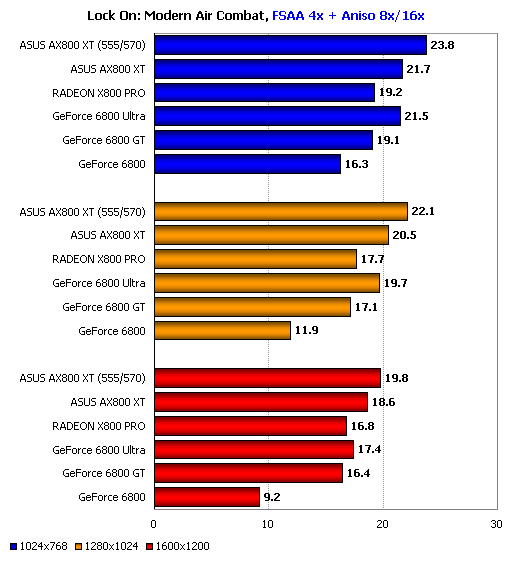
In Eye Candy mode, the ASUS product demonstrates the same performance as the GeForce 6800 Ultra, but when overclocked it starts to outperform it by about 10 percent.
Game Tests: Colin McRae Rally 04
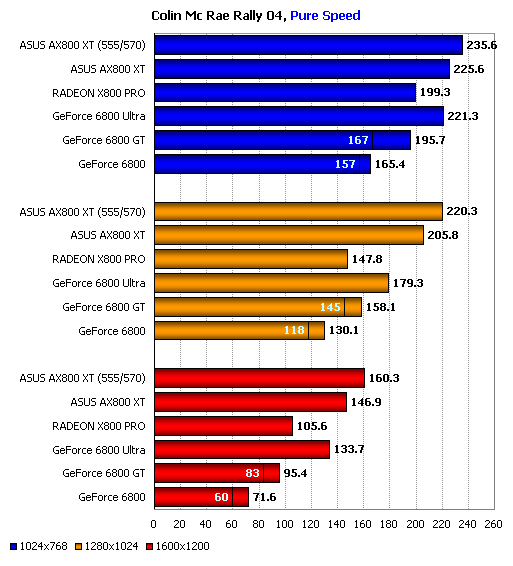
This car simulator is based on a modern engine that actively uses complex pixel shaders to create special effects. Consequently, the result is quite predictable – the first place in this test is rightfully taken by ASUS AX800 XT, which quickly works with complex pixel shaders that require large amounts of computation. In this case, overclocking the AX800 XT gives a noticeable performance boost, since the VPU frequency rises, and the processing speed of the aforementioned pixel shaders directly depends on it.
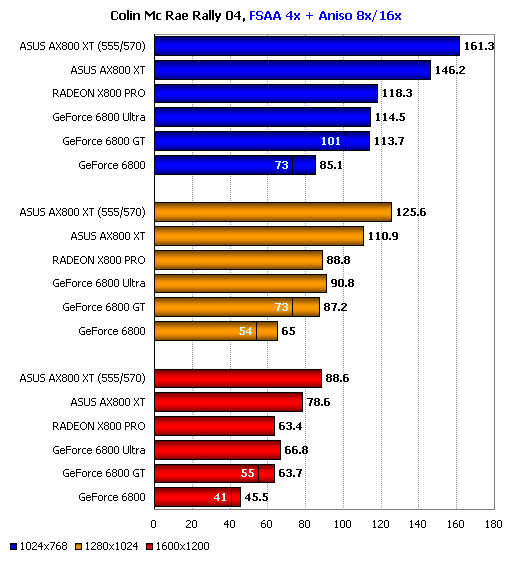
Unlike the Il-2 Sturmovik, when anti-aliasing and anisotropic filtering are enabled in Colin McRae Rally 04, the situation looks quite ordinary – the increased load on the memory subsystem allowed ASUS AX800 XT to show itself in the best possible way, and the overclocking effect was also quite impressive.
Game tests: Command & Conquer Generals: Zero Hour
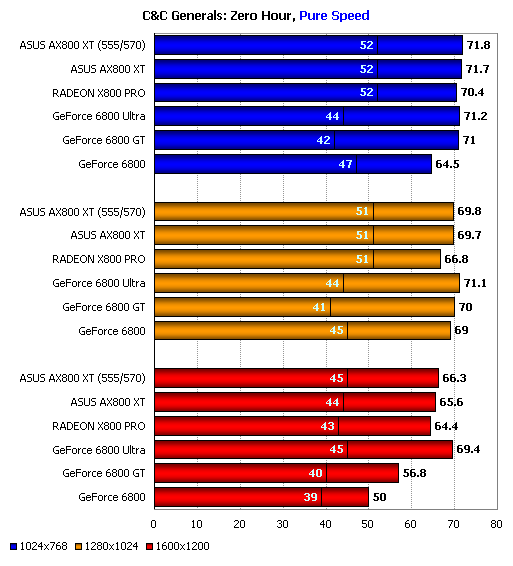
Up to a resolution of 1600×1200, it is almost impossible to detect any noticeable difference in performance between high-end cards, and even in 1600×1200 the difference between ASUS AX800 XT and GeForce 6800 Ultra does not exceed three frames per second.
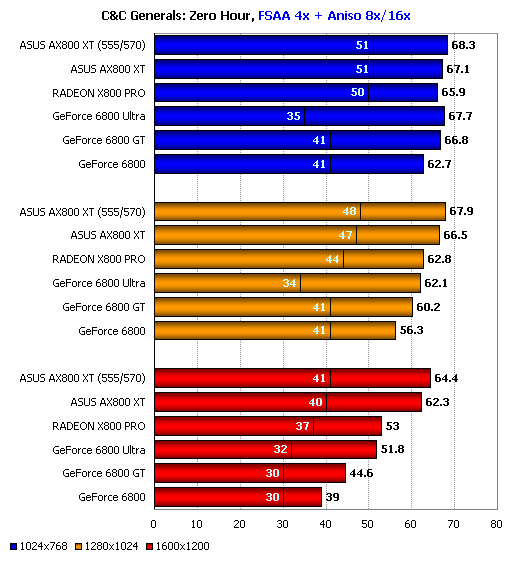
In Eye Candy mode, the difference is visible starting from 1280×1024 resolution. In it, the ASUS AX800 XT product begins to demonstrate a slight advantage over the GeForce 6800 Ultra, which then significantly increases in the 1600×1200 resolution, due to the reasons described above.
Game Tests: Perimeter
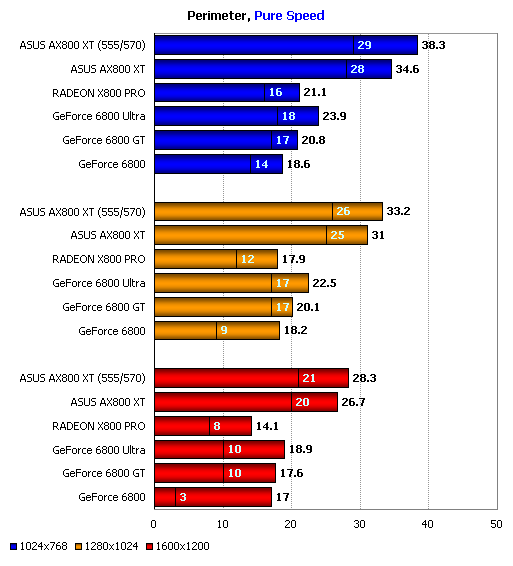
Perimeter, as our readers probably already know, is an extremely demanding game in the processing speed of complex pixel shaders, so the victory of ASUS AX800 XT in this test is quite natural. Perhaps this is the only video adapter from the tested, on which you can comfortably play this real-time strategy.
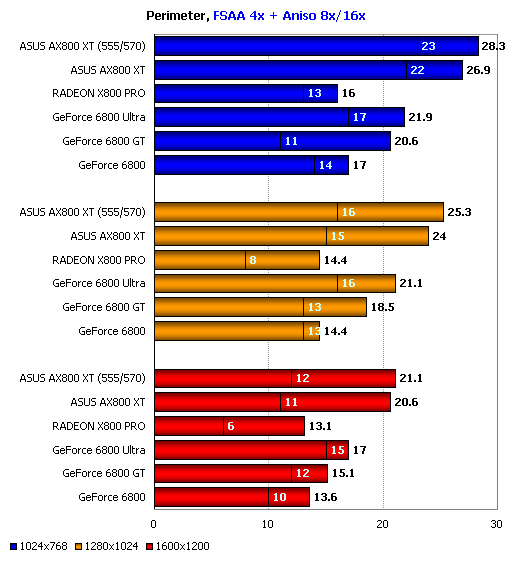
Nothing special happens when FSAA and AF are enabled, and the advantage remains for ASUS X800 XT – both normal and overclocked. However, in this mode, it becomes much less comfortable to play, since the minimum FPS values fall below 25 frames per second. This game is tested in manual mode, so the results may not be entirely accurate.
Semi-synthetic tests: Aquamark3
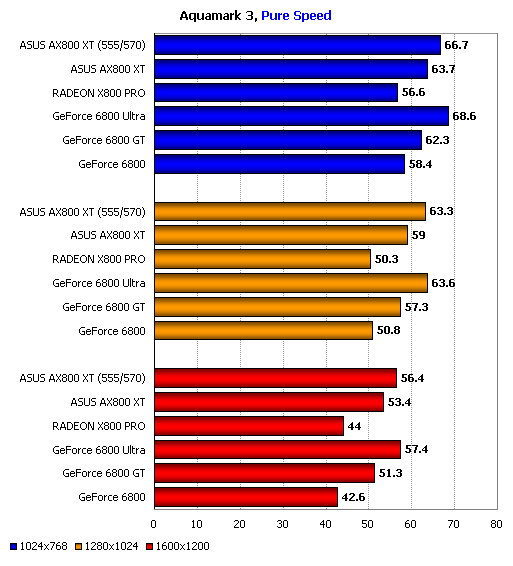
The peculiarity of this test is that the overdraw coefficient is very high in it, and the geometry of the scenes is very complex. At the same time, there are few pixel shaders, especially complex ones, which is why Aquamark3 shows the best results on NVIDIA cards, in particular, on the GeForce 6800 Ultra. However, overclocking allows ASUS AX800 XT to achieve the same performance level.
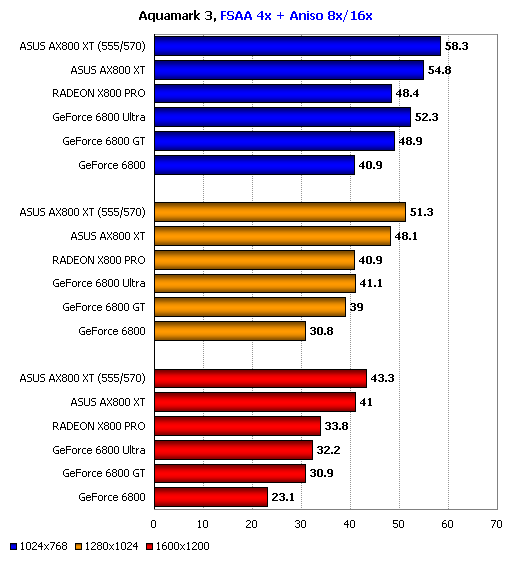
In the Eye Candy mode, the rivals change places – now the ASUS card becomes the leader, and all thanks to the efficient work with the memory subsystem. In this case, the superiority over the GeForce 6800 Ultra is quite significant – with general indicators of about 30-60 FPS, the described product outperforms its main rival by about 7 frames per second at high resolutions.
Synthetic tests: Futuremark 3DMark03
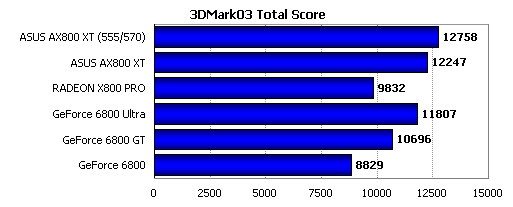
In the overall 3DMark03 standings, ASUS AX800 XT outperforms the GeForce 6800 Ultra, however, the overall result, expressed in points, says little, so let’s look at the results of individual gaming tests.
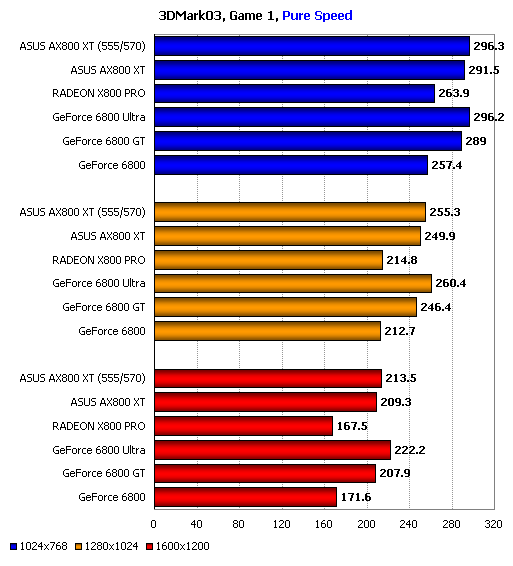
The first test is very simple – only DirectX 7 capabilities and no pixel shaders. It is not surprising that the GeForce 6800 Ultra performs better in it than the ASUS AX800 XT.
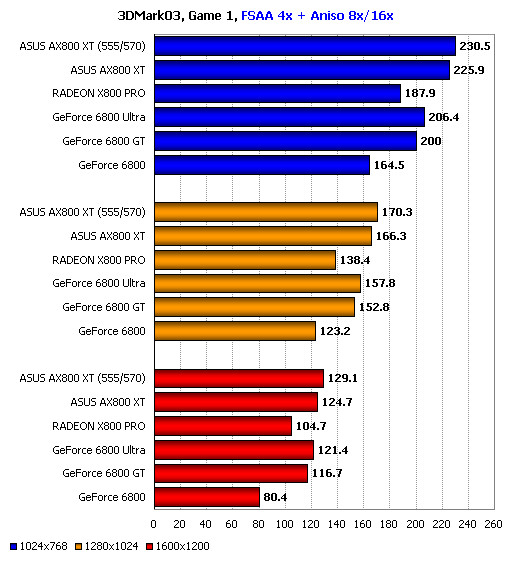
Nevertheless, the hero of our review manages to show himself in a mode with full-screen anti-aliasing and anisotropic filtering enabled at the same time – here it demonstrates better results than GeForce 6800 Ultra, however, the gap narrows as the resolution increases and becomes almost invisible at 1600×1200. Overclocking has almost no effect.
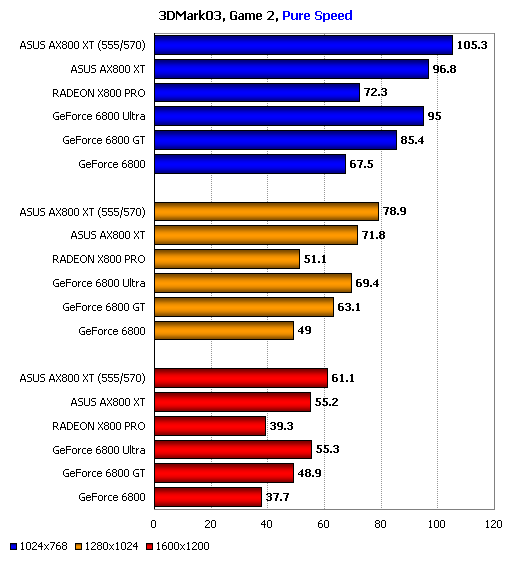
The second gaming test is a favorable atmosphere for NVIDIA cards, however, and ASUS AX800 XT does not hit the dirt in it, demonstrating the same performance level as the GeForce 6800 Ultra, and even outperforming it in overclocked mode. An excellent result, considering that the ASUS product is playing “out of place” here – quite simple pixel shaders version 1.4 are used in the test, but the scene construction algorithm is such that NVIDIA cards, which are able to quickly work with shadows, feel best in it. thanks to the optimized work with the Z-buffer.
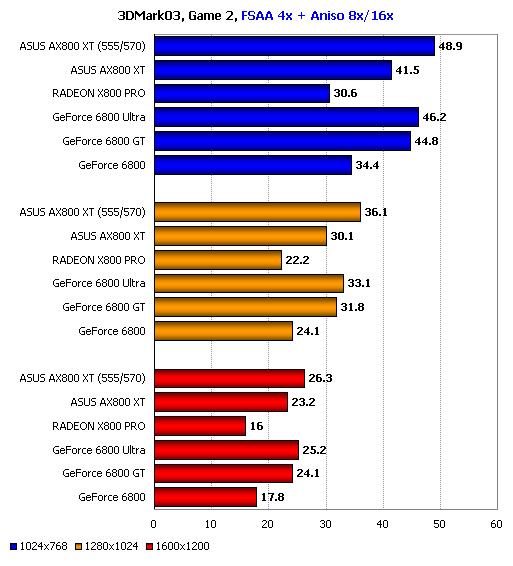
This is proof that the NV40 architecture is better adapted to the conditions of the second gaming test than the ATI R420 architecture – here the GeForce 6800 Ultra is slightly ahead of the ASUS AX800 XT. However, it manages to come out ahead in overclocking mode.
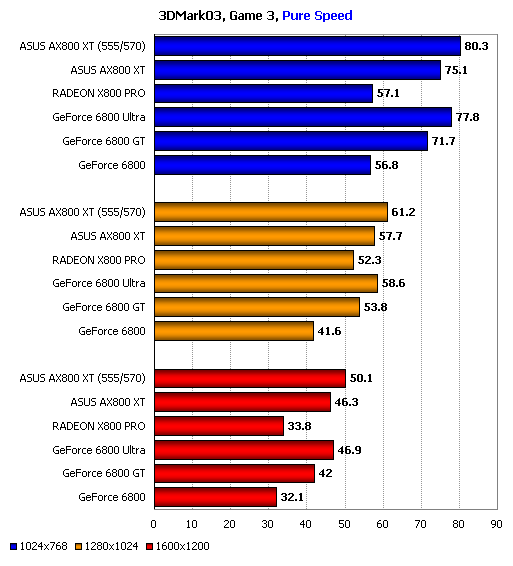
The results of the third game test practically repeat the picture observed in the second, and this is not surprising – the third test of the 3DMark03 package uses the same scene building algorithms as the second one.
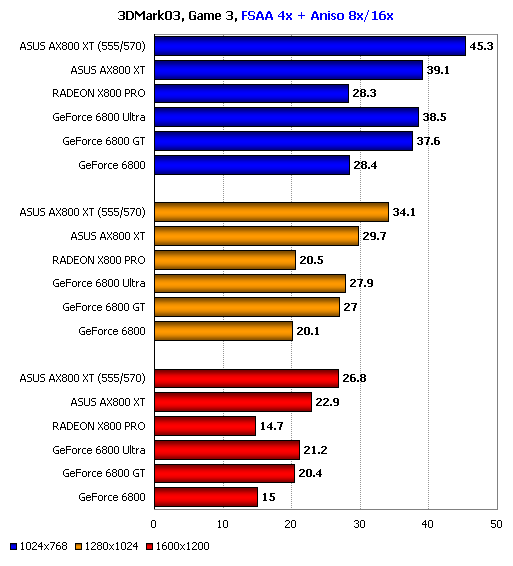
Nevertheless, in the Eye Candy mode the situation looks a little different – here ASUS AX800 XT is not inferior to its rival from the beginning and even surpasses it in high resolutions, and overclocking generally makes it the undisputed leader in this test.
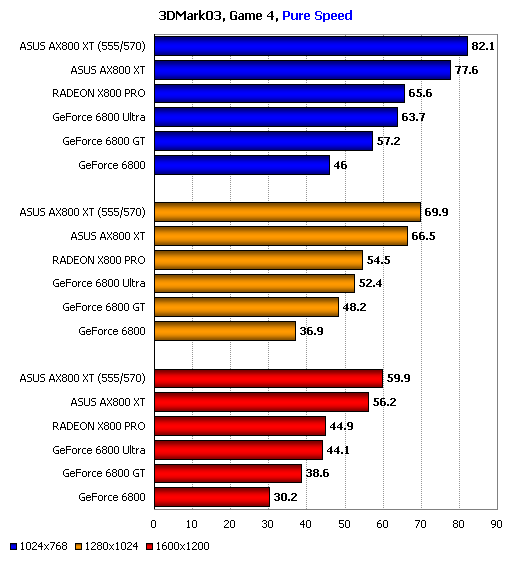
The fourth game test needs no comments. Since it is full of pixel shaders that require complex mathematical calculations, the victory of ASUS AX800 XT looks quite natural.
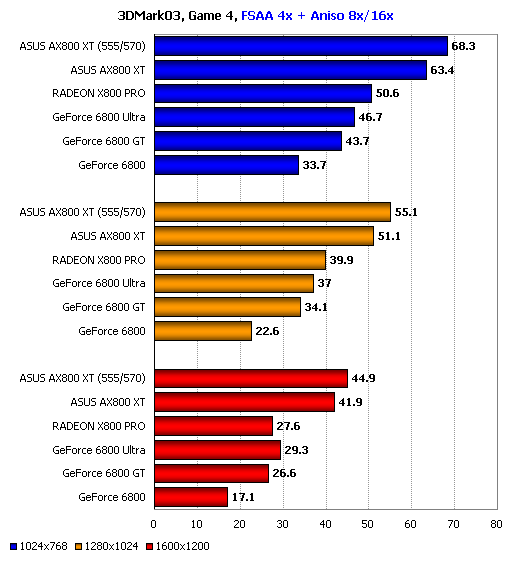
The same can be said about the results obtained with the simultaneous activation of anti-aliasing and anisotropic filtering. So, the victory of ASUS AX800 XT looks more than natural – the hero of our review did not lose face in any of the 3DMark03 tests. On the contrary, it practically did not yield to its main rival GeForce 6800 Ultra in the first three tests and significantly outperformed it in the fourth, most difficult test.
Conclusions and conclusion
The ASUS AX800 XT / TVD video adapter left a very favorable impression of itself, with the exception of one drawback – a relatively ineffective cooling system. As for the rest, it is an excellent product with excellent performance and the richest package bundle that will appeal to any computer enthusiast. True, it, like all cards belonging to the X800 family, does not support Shader Model 3.0, but its support at the moment is a very ephemeral advantage that gives almost no benefit, since the only game that supports shaders of the third version is Far Cry … In addition, 3DMark05 also supports them , however, it is not a game, but a tool for testing video adapters, so it is not of particular interest for game lovers.
For the convenience of assessing the overall performance of ASUS AX800 XT, we have summarized the obtained data in diagrams:
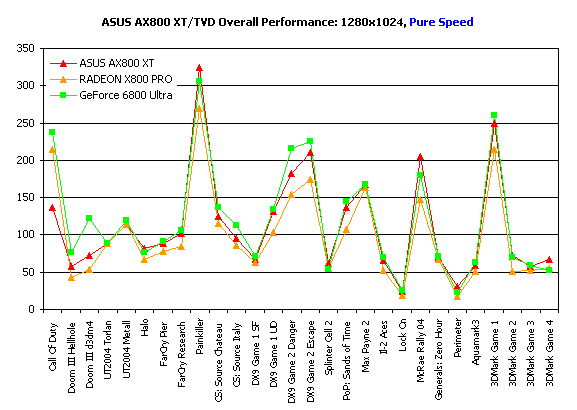
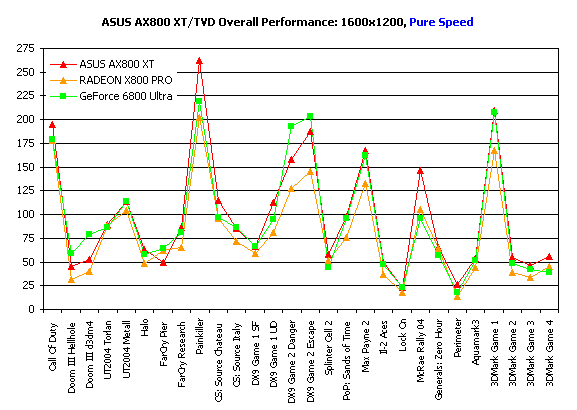
As you can see, in Pure Speed mode, ASUS AX800 XT performance is roughly equal to that of the GeForce 6800 Ultra, except in some cases like the 3D shooter Doom 3, which prefers exclusively NVIDIA cards, or one of the levels of the preliminary version of the first next-generation game that we used in our testing. … In some other cases, for example, in Painkiller and Colin McRae Rally 04, the ASUS product significantly outperforms the GeForce 6800 Ultra, due to the fact that it can quickly work with complex pixel shaders.
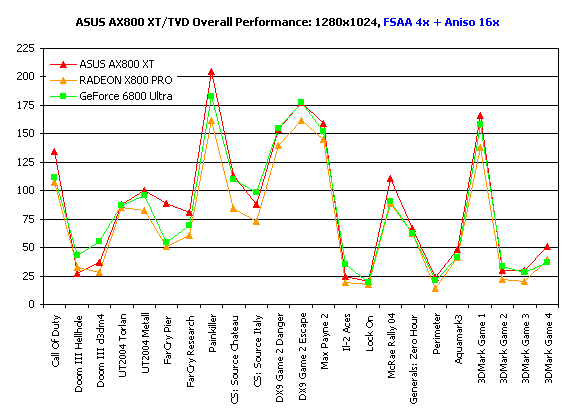
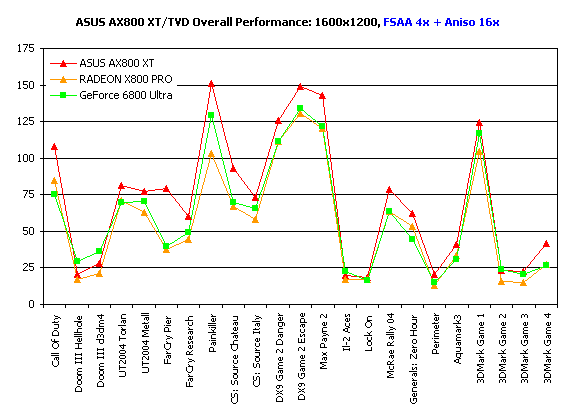
In Eye Candy mode, that is, with the simultaneous inclusion of full-screen anti-aliasing with a degree of 4x and anisotropic filtering for 16 samples, ASUS AX800 XT demonstrates much more impressive results, in general, outperforming the GeForce 6800 Ultra in most applications, with the exception of the same Doom 3 and flight simulator IL-2 Sturmovik: Aces in the Sky. At 1600×1200 the picture is even more optimistic – highly efficient methods of working with video memory allow the ASUS product to feel even more confident than in 1280×1024.
Another drawback that we did not mention earlier is the high cost of ASUS AX800 XT / TVD – according to Pricewatch.com, prices for this product start at $ 585 and can reach amounts exceeding $ 700. However, this product belongs to the highest class of video adapters, so this price should not be surprising – the richest equipment and the highest performance are not for nothing. However, true enthusiasts are unlikely to be stopped by the price – and we may well recommend them to opt for the ASUS AX800 XT / TVD. Nevertheless, there is one wish to the manufacturer – it is necessary to rework the cooling system in order to increase its efficiency, since in its current form it is not always capable of providing adequate cooling of such a high-speed card.
ASUS AX800 XT / TVD: advantages and disadvantages
Advantages:
High performance
High quality 2D
Support for VIVO functions
Good overclocking potential
Spectacular appearance
Support for proprietary ASUS technologies
Rich bundle
Flaws:
Insufficiently efficient cooling system
High price





